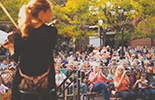cultural districts
cultural districts
Rethinking Cultural Districts for Small Towns in Small States
cultural districts
2015 Honoree -
Biography
Annise Parker, Mayor of Houston, Texas, received the 2015 National Award for Local Arts Leadership for cities with a population of 100,000 or more at the United States Conference of Mayors’ Winter Meeting.
cultural districts
AAF Ad 3

Ms. Ruby Lopez Harper
Columbia, South Carolina
Posted by Sep 20, 2016

Ms. Ruby Lopez Harper
On a trip to teach and learn about cultural districts in South Carolina, I was struck by the desire of each district to develop relationships with the others and to work together to promote each other’s cultural assets and build knowledge about the state across the state.
Read More
Mr. Jay H. Dick
Plastered in Paducah
Posted by Jul 29, 2015

Mr. Jay H. Dick
I first learned about Paducah, KY eleven years ago when I started working at Americans for the Arts. Where is Paducah, you ask? Well, it’s a town of about 25,000 people nestled where the Ohio and Tennessee rivers converge, approximately 140 miles north of Nashville in the western sliver of Kentucky. But don't let this quaint town fool you, as it packs a huge arts punch.
Read More
Mr. Jay H. Dick
The Arts Mean Business
Posted by Apr 28, 2015

Mr. Jay H. Dick
If your city had a new construction company move to town, this would be good news – more jobs, more economic activity, and more tax revenues to be collected. How about if your city received funding from your state to widen a road? Again, you would probably welcome this news with open arms. Now, think about a new arts organization moving to town. Would you look at this group with the same economic lens that you used to look at the construction or transportation business?
Read More
Mr. Ken Busby
A Tulsa Take on Fellowship – Listen Up Artists!
Posted by Mar 06, 2015

Mr. Ken Busby
Those of you who read my periodic blogs know that I have a real passion for Tulsa. As I've described the Brady Arts District where the Hardesty Arts Center, Guthrie Green, Philbrook Downtown, and Woody Guthrie Center reside along with a growing number of arts-related venues, restaurants, and boutiques, I've received comments from a number of readers that they had no idea Tulsa had so much going on in the arts.
Read More
Theresa Cameron
Cultural Districts and Communities: Catalysts for Change
Posted by Feb 06, 2015

Theresa Cameron
This week’s blog salon on Cultural Districts and Communities: Catalysts for Change explored how cultural districts are improving, engaging, and sometimes changing their communities. Kicking off the salon, I introduced our new tool - the National Cultural Districts Exchange, which is a suite of online tools and resources to provide research and information about cultural districts. This new resource is meant to be an exchange of ideas, information, and resources - and this blog salon supplemented this new tool with great viewpoints and unique perspectives on cultural districts.
Read More
Mr. Tom C. Borrup
Hôtel du Nord: You Can Check Out, But It Will Never Leave You
Posted by Feb 06, 2015

Mr. Tom C. Borrup
I’ve had many great opportunities to witness how different communities organize themselves through, around, or into arts and cultural districts. In September, 2014, I had the pleasure of visiting a community in Marseille (800,000 population) in the south of France, a cluster of 8 small neighborhoods that formed a fascinating and alluring heritage and creative district with an approach I hadn’t seen in the United States.
Marseille was motivated by the opportunity to serve as European Capital of Culture for 2013, an effort that brought together players across government, creative, and business sectors to build working relationships like they never had before. The now 30-year-old Capital of Culture program rotates through the nations of the EU selecting cities to show off their distinctive creative and cultural assets. A total of 75 municipal entities in the Provence region (1.8 million population) – an area with no history of regional planning and little cooperation – demonstrated unprecedented unity and cultural vitality for their year in the European spotlight. It was branded Marseille-Provence 2013 or MP2013.
Read More
Michael Killoren
NEA weighs in on Cultural Districts and the new Cultural Districts Exchange
Posted by Feb 06, 2015

Michael Killoren
There are two questions that I frequently hear when asked about arts and cultural districts: what exactly does it mean to be a cultural district, and how does my community go about designating one?
These are big, complicated questions because there are so many variables! Finding meaningful and helpful answers, analysis, and insight to these questions just got easier, thanks to the National Cultural Districts Exchange, a free online resource. Now, you can find comprehensive information on the formation of cultural districts -- including DIY templates, with sample legislation, and guidelines covering all aspects of district designation - all in one place.
Read More
Mr. Randall Rosenbaum
In Rhode Island, Size Often Matters… Even When It Comes to Cultural Districts
Posted by Feb 06, 2015

Mr. Randall Rosenbaum
Size drives a lot of policy discussions in Rhode Island. We are, after all, a unit of measure. “That iceberg off the coast of Nova Scotia is about the size of Rhode Island.” But for Rhode Islanders we take pride in how our small state is an intimate place, and we discuss ways we can use that intimacy to our advantage.
Twenty-plus years ago we were one of the first states in the nation to establish cultural districts in select communities. These districts had two distinct but complimentary goals: the first was to attract an art-buying (and money-spending) public, and the second was to encourage artists to live and work in areas that would benefit greatly from their presence.
Read More
James Brooks
Arts Strategies from Cleveland and Dayton
Posted by Feb 05, 2015

James Brooks
The Gordon Square Arts District (GSAD), which is located in Cleveland’s Westside neighborhood, has four major goals – to improve the district’s streetscapes, to create additional parking throughout the district, to restore and renovate the Cleveland Public Theatre and the Capitol Theatre, and to build a permanent home for the Near West Theatre inside the district.
Read More
Gayle Kaler
The Cultural District: The Key to a City’s Heart
Posted by Feb 05, 2015

Gayle Kaler
Cultural districts are the heartbeat of a city. They are the distinctive part that makes your city unique and reveals the character and spirit of your town. They are vital to the sustainability and creativeness of a city, but so often these districts are forgotten and underutilized as a tool for economic growth and viable livability.
As Mayor of Paducah, Kentucky, a city of approximately 25,000, I have seen first-hand how the rejuvenation of a cultural district can have a significant impact on the economic stability and viable livability of an area. Our local government and concerned citizens have invested in, nurtured and supported the growth of our local arts district for many years and we are reaping great rewards from that investment. Paducah has used artist relocation programs, district rejuvenation projects, fiber art attractions, and cultural organization partnerships to create an arts district that is having an impact on both the local economy and the international playing field.
Read More
Ms. Victoria L. Hamilton
Search and You Shall Find... a Cultural Destination
Posted by Feb 05, 2015

Ms. Victoria L. Hamilton
Since the inception of our work at the Jacobs Center for Neighborhood Innovation (JCNI), arts and culture taken form in the development of an emerging cultural district, bringing together community members, organizations, and artists to shape both its look and character.
Read More
Ms. Kerry Adams Hapner
Inspiration Lives Here.
Posted by Feb 04, 2015

Ms. Kerry Adams Hapner
Inspiration: Symphony Silicon Valley’s musicians, instruments in hand, bustling in and out of the beautifully renovated 1927 California Theatre. Crowds lined up to see Opera San Jose’s latest production of Rigoletto. The Subzero art festival, during which the streets are jammed with a mix from Millennials to families to empty nesters - all curious about the art work of creative entrepreneurs and eclectic music performances. Youth mixing new music and producing new multimedia projects at MACLA’s PeaPod Academy. Art loading into the galleries. Anonymous and whimsical artistic expressions of yarn bombed bike racks and light poles. Sidewalk cafes with people dining to see and be seen – and yes, be inspired. This is the daily life of San Jose’s SoFA district.
Read More
Mayor Jim Brainard
Mayor Jim Brainard on Carmel, Indiana's Arts and Culture District
Posted by Feb 04, 2015

Mayor Jim Brainard
As American suburbs developed in the years after World War II, people tended to think of them as little more than places to sleep after a long day working in the big city nearby. They made their homes, educated their kids and went to church in the suburbs. But when it came to experiencing the arts, they were forced to get in their cars and drive into the core of the big city.
In Carmel, Indiana – a suburb north of Indianapolis that has grown to more than 85,000 residents – we chose to do things differently. We thought it was important that our “bedroom suburb” have easy access to the arts. As busy families began to seek other forms of entertainment closer to home, we recognized that they stood the risk of missing out on experiencing the arts telling the story of our country through dance, music, and sculpture.
Read More
Rebecca Chan
Cultural Districts as Community Connectors
Posted by Feb 03, 2015

Rebecca Chan
Baltimore’s three cultural districts are each reflections of the distinctive neighborhoods and communities in which they are situated: the Bromo Tower, Highlandtown, and Station North Arts & Entertainment District. An inherently place-based practice, each District operates under a different management structure, producing programming and projects tailored to the strengths and challenges in each District that serve the artists, businesses, and residents in their respective neighborhoods.
Read More
Caron Atlas
Neighbors and Strangers
Posted by Feb 03, 2015

Caron Atlas
“We fought poverty, violence and blight, and we made the Southside a better place to live. We are now strangers in our own neighborhood, and it’s painful.”
These words from longtime Brooklyn resident and community leader Evelyn Cruz at a forum about gentrification in Williamsburg have stuck with me for years. I thought of them as we created Naturally Occurring Cultural Districts New York (NOCD-NY), a citywide alliance of artists, cultural organizations, and community leaders coming together to revitalize New York City from the neighborhood up. And I’m thinking about them now as I write this blog about cultural districts and communities as catalysts of change. How can we make sure that our work does not make people strangers in their own neighborhoods?
Read More


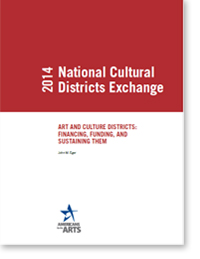
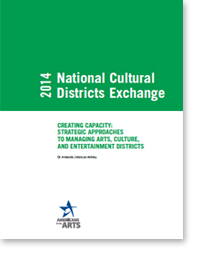
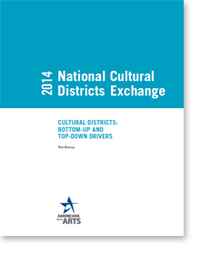
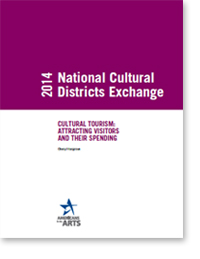


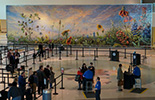
 LEARN MORE
LEARN MORE

